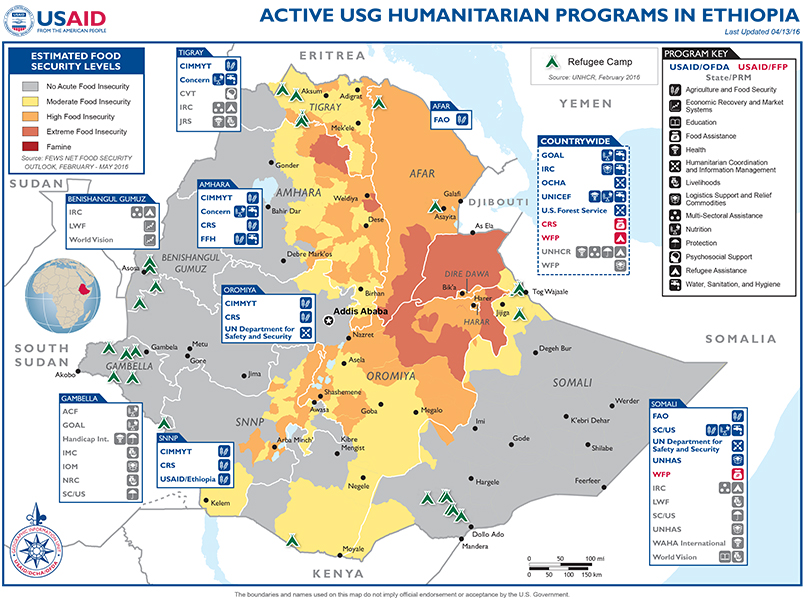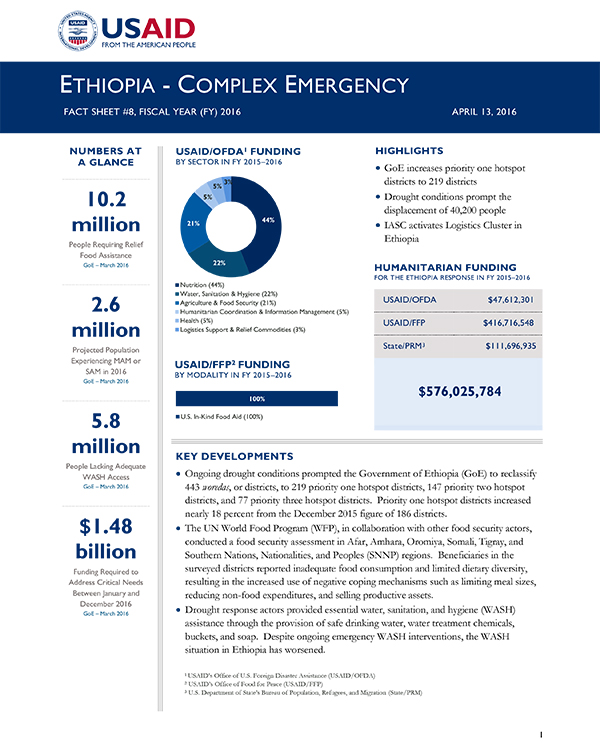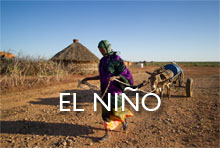- What We Do
- Agriculture and Food Security
- Democracy, Human Rights and Governance
- Economic Growth and Trade
- Education
- Ending Extreme Poverty
- Environment and Global Climate Change
- Gender Equality and Women's Empowerment
- Global Health
- Water and Sanitation
- Working in Crises and Conflict
- Disaster Assistance
- Political Transition Initiatives
- Conflict Mitigation and Prevention
- Countering Violent Extremism
- Disaster Risk Reduction
- Peacebuilding and Reconciliation
- Providing Safe & Secure Environments for Development
- Recovering From Crisis
- Resilience
- Tech Challenge for Atrocity Prevention
- World Humanitarian Day
- U.S. Global Development Lab
April 13, 2016
Highlights
GoE increases priority one hotspot districts to 219 districts
Drought conditions prompt the displacement of 40,200 people
IASC activates Logistics Cluster in Ethiopia
Key Developments
Ethiopia Map - 04-13-2016 ![]() (pdf - 1017k)
(pdf - 1017k)
Numbers At A Glance
10.2 million
2.6 million
5.8 million
$1.48 billion
Humanitarian Funding
For the Ethiopia Response
FY 2015 - 2016
| USAID/OFDA | $47,612,301 |
| USAID/FFP | $416,716,548 |
| State/PRM | $111,696,935 |
| TOTAL | $576,025,784 |
Ongoing drought conditions prompted the Government of Ethiopia (GoE) to reclassify 443 woredas, or districts, to 219 priority one hotspot districts, 147 priority two hotspot districts, and 77 priority three hotspot districts. Priority one hotspot districts increased nearly 18 percent from the December 2015 figure of 186 districts.
The UN World Food Program (WFP), in collaboration with other food security actors, conducted a food security assessment in Afar, Amhara, Oromiya, Somali, Tigray, and Southern Nations, Nationalities, and Peoples (SNNP) regions. Beneficiaries in the surveyed districts reported inadequate food consumption and limited dietary diversity, resulting in the increased use of negative coping mechanisms such as limiting meal sizes, reducing non-food expenditures, and selling productive assets.
Drought response actors provided essential water, sanitation, and hygiene (WASH) assistance through the provision of safe drinking water, water treatment chemicals, buckets, and soap. Despite ongoing emergency WASH interventions, the WASH situation in Ethiopia has worsened.
CURRENT EVENTS
Given extended drought conditions, the GoE, in collaboration with UN agencies and humanitarian organizations, reclassified priority hotspot districts—a classification of districts most in need of humanitarian assistance based on the impact of food availability, WASH infrastructure, access to markets, the nutrition situation, and other contributing factors—to 219 priority one hotspot districts, 147 priority two hotspot districts, and 77 priority three hotspot districts. The number of priority one hotspot districts has increased nearly 18 percent from the December 2015 figure of 186 and more than fivefold since February 2015, when the GoE and relief organizations identified 40 hotspot priority one districts.
Continued drought conditions prompted the displacement of more than 40,200 people in Afar, Amhara, and Somali during March, including 12,900 people in Afar and 17,200 people in Somali, according to the International Organization for Migration (IOM). Between August 2015 and March 2016, extended drought conditions displaced approximately 188,000 people in Afar, Amhara, Oromiya, and Somali, according to IOM.
FOOD SECURITY
In late February, WFP and other food security actors conducted a food security assessment in 69 districts of Afar, Amhara, Oromiya, SNNP, Somali, and Tigray. Beneficiaries in the surveyed districts receive food assistance from different sources—WFP, the GoE, or the USAID/FFP-supported Joint Emergency Operation (JEOP)—depending on location.
Households across the surveyed areas reported inadequate food consumption and limited dietary diversity. Of the more than 820 households interviewed, harvested crops provided an average of only 4 percent of monthly food requirements, reflecting significant losses in harvests. Additionally, cash purchases of food provided 17 percent of monthly household food requirements, while credit from lenders covered another 4 percent of food requirements. The survey found that households in the lowest income quintile were meeting 15 percent of their food requirements through their own harvests—an 8 percent decrease compared to November 2015. Insufficient food supplies have forced surveyed households to employ negative coping mechanisms, including limiting meal sizes, skipping meals, reducing non-food expenditures, and selling productive assets, charcoal, and firewood.
Despite humanitarian actors distributing relief food assistance in affected areas, households are not meeting minimum caloric needs. Approximately 10 percent of surveyed households reported receiving less than 6 kilograms of cereals, equaling less than 10 percent of daily caloric needs for a five-person household and more than 65 percent of assessed households had no access to pulses.
In Amhara, approximately 95 percent of households reported low dietary diversity, the highest percentage of households among surveyed regions. An estimated 92 percent of households in Amhara spent more than 65 percent of their monthly expenditures on food purchases. WFP noted that food prices in Amhara are higher than other regions, and many households reported receiving only partial food basket rations.
More than 6 million children in Ethiopia are confronting critical food shortages as a result of the current drought, according to the non-governmental organization (NGO) Save the Children/U.S. (SC/US). The NGO urged the international community to increase fiscal support to drought response efforts.
LOGISTICS
Logistics constraints, including challenges delivering relief commodities into Ethiopia and transporting items within the country, continue to hinder the efficiency of the drought response. On March 24, the Inter-Agency Standing Committee (IASC) activated the Logistics Cluster—the coordinating body for humanitarian logistics activities, comprising UN agencies, NGOs, and other stakeholders—to identify logistics bottlenecks, propose solutions to overcome logistics challenges, and support national- and regional-level GoE institutions and humanitarian partners to ensure an effective response. WFP, the global lead agency for the Logistics Cluster, is supporting the GoE and humanitarian partners with logistics coordination and information management.
A logistics technical expert is working with the USAID Disaster Assistance Response Team (DART) in Ethiopia to assess the food assistance supply chain—the food response is one of the sectors most constrained by logistics challenges. The logistics expert plans to collaborate closely with the Logistics Cluster.
On March 31, GoE officials and regional authorities in northwestern Somalia signed an accord to facilitate trade through Somali’s Port of Berbera, according to international media. The GoE has expressed plans to expand use of the Port of Berbera for commercial shipments destined for Ethiopia; however, the Port of Djibouti remains the primary port for shipments destined for Ethiopia. WFP utilizes the Port of Berbera to import relief food assistance destined for Somali, Ethiopia. In February, WFP shipped approximately 40,000 metric tons (MT) of wheat through Berbera to support Ethiopians in Somali, international media reports.
AGRICULTURE
On March 24, GoE representatives, USAID partners and other NGOs, public and private seed suppliers, and cooperative farmer unions convened an emergency seed meeting in Amhara to discuss the implementation of the USAID-funded seed distribution program. The participants discussed drought mitigation efforts, identified seed suppliers and distribution mechanisms, and appointed regional-, zonal-, and district-level contacts for planning seed distributions and resolving challenges. To date, USAID has provided approximately $8 million for emergency seed interventions that will benefit more than 300,000 drought-affected households.
NUTRITION AND WASH
With nearly $3.3 million in USAID/OFDA funding, NGO Concern is implementing nutrition interventions in 11 districts of Amhara and four districts of Tigray. As of late March, Concern was providing targeted supplementary feeding programs (TSFPs) to more than 5,000 acutely malnourished women and children in Tigray’s Debark District. All of the districts covered by Concern in Tigray are hotspot priority one districts, and the NGO reported having sufficient corn soy blend plus rations—a formulated supplementary food—for six months of interventions in the region.
During the first quarter of 2016, the GoE and other response partners treated more than 546,000 acutely malnourished people in Ethiopia through TSFPs—82 percent of the 665,000 people targeted during the quarter, according to the UN.
On April 11, USAID/OFDA partner the UN Children’s Fund (UNICEF) outlined the 2016 emergency plan of action regarding infant and young child feeding (IYCF) interventions in Ethiopia. The 2016 IYCF emergency plan, developed with USAID/OFDA support, involves multiple levels of action to address critical acute malnutrition levels during 2016. The 2016 emergency IYCF plan calls for relief organizations to improve communication with affected communities and support increased IYCF trainings for local health care workers. In addition, humanitarian actors emphasize increased IYCF awareness and ownership among health care staff across the Ethiopian health system. Finally, relief organizations should integrate IYCF activities with existing guidance and activities for treating moderate acute malnutrition, including community-based management of acute malnutrition.
Between January and March, drought response actors provided critical WASH assistance, including delivering 1.7 million packets of safe drinking water; disinfecting approximately 1,000 water sources; providing more than 6,100 buckets and 40,400 pieces of soap; and reaching an estimated 130,000 people with hygiene promotion messages, the WASH Cluster reports.
The severe drought continues to deplete water supplies and exacerbate WASH-related needs among affected communities. Significant water-trucking requirements have also increased the cost of WASH assistance, and anticipated increases in water-trucking needs will only further expand the gap in water-trucking availability.
HEALTH
GoE Ministry of Health (MoH) officials have reported confirmed measles cases in Afar, Amhara, Oromiya, Somali, and SNNP. The MoH, in partnership with UNICEF and the UN World Health Organization (WHO), plans to launch a measles vaccination campaign in coordination with a polio vaccination campaign in mid-April, targeting an estimated 28 million children between six months and 15 years of age. UNICEF is supporting GoE efforts by providing technical assistance and vaccine procurement services.
As of March 23, WHO had reported more than 1,100 cases of acute watery diarrhea (AWD) in Somali’s Borena and Liben zones, Oromiya’s Borena Zone, and SNNP’s Gamo Gafo, Gurag, and Segen zones since November 2015. Liben Zone’s Hudet and Moyale districts have the highest reported incidences of AWD, with more than 450 cases treated, representing 40 percent of all cases.
USAID/OFDA partner UNICEF has distributed water treatment chemicals—including approximately 622,000 sachets of water purifiers, 26,300 strips of Aquatabs, 5,000 bottles of WaterGuard, and 45 drums of calcium hypochlorite—to areas with cases of AWD. UNICEF has provided 20,000 liters of water through water-trucking services for 2,000 people in SNNP and reached more than 116,000 students in 230 schools in the region with AWD sensitization campaigns. In addition to UNICEF and WHO, Médecins Sans Frontières and USAID/OFDA partners the International Rescue Committee and SC/US are responding to the AWD outbreak.
INTERNATIONAL HUMANITARIAN ASSESSMENTS
On April 8, the European Commission’s Department for Humanitarian Aid and Civil Protection (ECHO) announced approximately $139 million in additional humanitarian assistance for the Ethiopia drought response. The new funding will support life-saving interventions, as well as bolster early recovery efforts, to address critical humanitarian needs.
CONTEXT
Multiple consecutive seasons of below-normal rainfall and the current El Niño-induced drought have resulted in deteriorating agricultural, livestock, food security, and nutrition conditions in northeastern and central Ethiopia. By December 2015, the GoE estimated that 10.2 million people required relief food assistance and other humanitarian interventions during 2016.
USAID activated a DART on February 24, 2016, to lead the USG crisis response to the drought in Ethiopia. In support of the GoE, the DART is coordinating USG response activities in close partnership with the UN and other relief organizations. The DART—composed of humanitarian specialists based in Ethiopia—is addressing critical needs and examining ways to realign activities to respond to urgent assistance gaps. USAID also established an Ethiopia Drought Response Management Team based in Washington, D.C., to support emergency response efforts in Ethiopia.
While drought remains a major contributor to vulnerability in Ethiopia, negatively affecting the lives and livelihoods of farmers and pastoralists, populations also continue to confront other challenges—including seasonal flooding, localized intercommunal conflict, above-average food prices, disease outbreaks, and limited access to health and WASH services—that contribute to sustained humanitarian needs and an ongoing complex emergency in Ethiopia.
On October 7, 2015, U.S. Chargé d’Affaires, a.i., Peter H. Vrooman redeclared a disaster for Ethiopia in response to the ongoing complex emergency.
PUBLIC DONATION INFORMATION
The most effective way people can assist relief efforts is by making cash contributions to humanitarian organizations that are conducting relief operations. A list of humanitarian organizations that are accepting cash donations for disaster responses around the world can be found at www.interaction.org.
USAID encourages cash donations because they allow aid professionals to procure the exact items needed (often in the affected region); reduce the burden on scarce resources (such as transportation routes, staff time, and warehouse space); can be transferred very quickly and without transportation costs; support the economy of the disaster-stricken region; and ensure culturally, dietary, and environmentally appropriate assistance.
More information can be found at:
- USAID Center for International Disaster Information: www.cidi.org or +1.202.821.1999.
- Information on relief activities of the humanitarian community can be found at www.reliefweb.int.










Comment
Make a general inquiry or suggest an improvement.